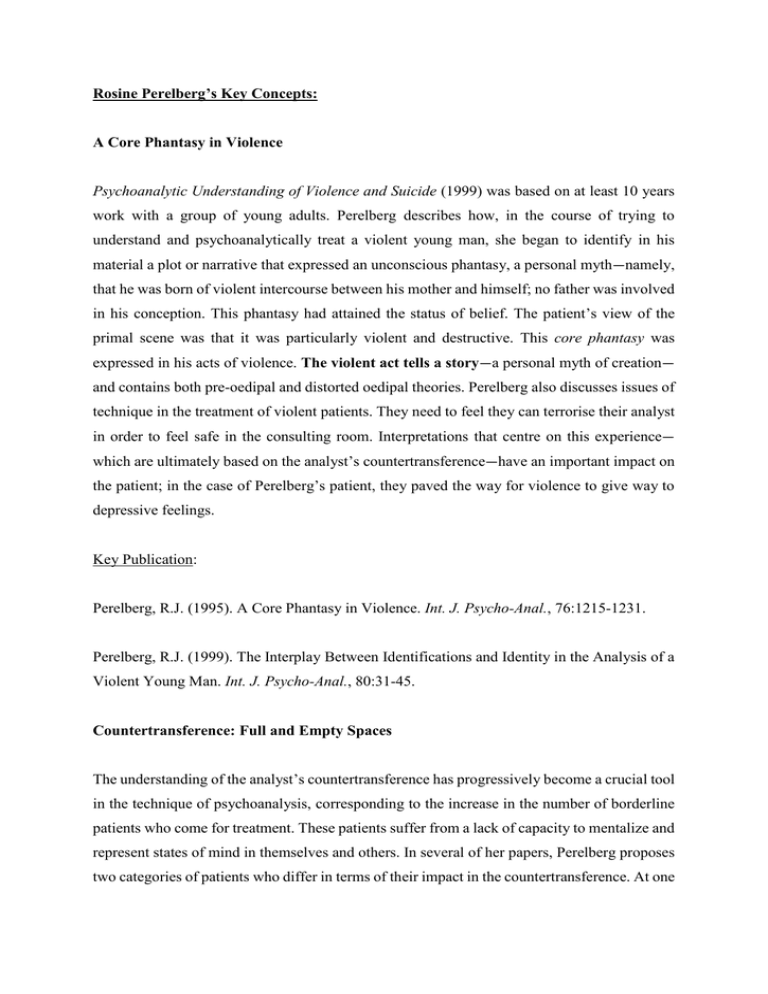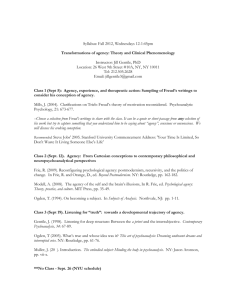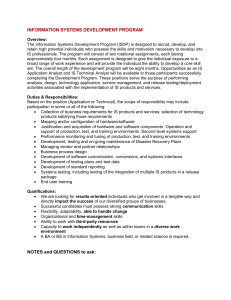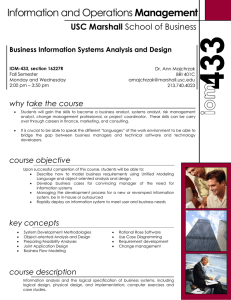
Rosine Perelberg’s Key Concepts:
A Core Phantasy in Violence
Psychoanalytic Understanding of Violence and Suicide (1999) was based on at least 10 years
work with a group of young adults. Perelberg describes how, in the course of trying to
understand and psychoanalytically treat a violent young man, she began to identify in his
material a plot or narrative that expressed an unconscious phantasy, a personal myth—namely,
that he was born of violent intercourse between his mother and himself; no father was involved
in his conception. This phantasy had attained the status of belief. The patient’s view of the
primal scene was that it was particularly violent and destructive. This core phantasy was
expressed in his acts of violence. The violent act tells a story—a personal myth of creation—
and contains both pre-oedipal and distorted oedipal theories. Perelberg also discusses issues of
technique in the treatment of violent patients. They need to feel they can terrorise their analyst
in order to feel safe in the consulting room. Interpretations that centre on this experience—
which are ultimately based on the analyst’s countertransference—have an important impact on
the patient; in the case of Perelberg’s patient, they paved the way for violence to give way to
depressive feelings.
Key Publication:
Perelberg, R.J. (1995). A Core Phantasy in Violence. Int. J. Psycho-Anal., 76:1215-1231.
Perelberg, R.J. (1999). The Interplay Between Identifications and Identity in the Analysis of a
Violent Young Man. Int. J. Psycho-Anal., 80:31-45.
Countertransference: Full and Empty Spaces
The understanding of the analyst’s countertransference has progressively become a crucial tool
in the technique of psychoanalysis, corresponding to the increase in the number of borderline
patients who come for treatment. These patients suffer from a lack of capacity to mentalize and
represent states of mind in themselves and others. In several of her papers, Perelberg proposes
two categories of patients who differ in terms of their impact in the countertransference. At one
extreme, there are patients who create an empty space in the analyst’s mind. The response they
evoke is a kind of depressive feeling that remains after they have left. They may bring dreams
and associations, but these do not reverberate in the analyst’s mind. The experience is one of
dryness, a dearth of memory, which may, at times, leave the analyst with a sense of exclusion
from the patient’s internal world. At the other extreme, there are patients who fill the consulting
room—with their words, dreams, and associations, but also with their emotions and their actions. For the analyst, the experience is one of being over-included in the patient’s world. Despite the differences between them, these two categories of patients share an experience of
something that cannot be represented in their internal world and is expressed in terms of either
an absence or an excess of affect. The pathway through which the analyst can understand both
these types of patients is via the counter-transference or, to put it differently, the analyst’s passion.
Key Publications:
Perelberg, R.J. (2003). Full and Empty Spaces in the Analytic Process. Int. J. Psycho-Anal.,
84:579-592.
Perelberg, R.J. (2015). Excess, Trauma and Helplessness: Repetitions and Transformations.
Int. J. Psycho-Anal., 96: 1453-1476.
Temporality: Descriptive Après-coup and Dynamic Après-coup
The infant is the baby of the past, observable in the development of an individual. The infantile,
according to Freud, is the child within the adult, who can only be reached through a process of
construction. The infant is subject to observation, but the infantile is the result of the analyst’s
reconstruction in the process of après coup. The specific object of psychoanalysis, as André
Green reminds us, is the unconscious, which one can reach only by approximations—this “other
thing” in Freud’s formulations, forever an “internal foreign body” in the words of Jean
Laplanche. The “real” child has been lost; in the consulting room one has access to memories
that have been invested with phantasy. This was the theme of Perelberg’s first psychoanalytic
paper, for which she was awarded the Cesare Sacerdoti Prize at the IPA Congress in Buenos
Aires in 1991. It culminated in her book Time, Space and Phantasy, published in 2008.
In The Controversial Discussions and Après-Coup, Perelberg proposed the distinction between
the descriptive après-coup, which designates the retrospective understanding in the here-andnow of a session, and the dynamic après-coup, which is deeply embedded in Freudian
metapsychology and implies a network of concepts such as repetition compulsion, sexuality,
and temporality in the context of the transference.
Key Publications:
Perelberg, R.J. (2006). The Controversial Discussions and Après-coup. Int. J. Psycho-Anal.,
87:1199-1220.
Perelberg, R.J. (2007). Space and Time in Psychoanalytic Listening. Int. J. Psycho-Anal.,
88:1473-1490.
Perelberg, R.J. (2008). Time, Space and Phantasy. London: Routledge. New Library of Psycho-Analysis. Preface by André Green.
Sexuality: Female Experience and the Maternal Body
Female Experience: Four British Women Analysts on Work with Women (1997, second edition
2008), co-edited with Joan Raphael Leff, examines the way in which women construct their
identification with their mother’s sexuality and the relevance of the construction of inner space
in the sequence of a woman’s development. The capacity to think about an inner bodily space
is crucially related to the capacity to have an internal mental space; the capacity to be able to
represent an internal body filled with female organs is linked to an identification with a mother
who not only has a capacity to mentalize, think, and interpret, but who is also experienced as
life-giving. In an analysis, one is confronted with the emergence of sexual phantasies derived
from the universal phantasies of the primal scene in their archaic forms. Perelberg believes that
the sexual solutions encountered by patients in analysis are, at times, attempts to resolve
psychic conflicts that are too painful and unbearable. When put into words, these conflicts may
be elaborated psychically. When erotism is less contaminated by anxieties about destruction
and death, then one’s capacity to possess one’s body and one’s sexuality is liberated.
Key Publication:
Perelberg, R.J. (1997). (Introductions 1 and 3: Raphael-Leff, J. and Perelberg, R.J. (Eds.)).
Female Experience: Four Generations of British Women Psychoanalysts on Work with
Women. London: The Anna Freud Centre, 2008.
Perelberg, R.J (2015). The Structuring Function of the Oedipus Complex. In Murdered Father,
Dead Father; Revisiting the Oedipus Complex. London: Routledge, pp. 125-169.
The Murdered Father and the Dead Father
Perelberg has suggested that the distinction between the murdered father and the dead father
is a tool for understanding different types of psychopathologies, myths, and literature. The
former—the murdered father—is present within an anal-sadistic structure where the father has
no symbolic place: the dead father. In “murdered father” configurations, patients find it
difficult, if not impossible, to make sense of the father’s role in the family structure. Examples
of this configuration are shown by patients who commit actual violence against men in a real
attempt to eliminate them. These patients have little or no ability to mobilize their aggression
in a way that would enable them to develop their capacity to work and to love. The dead father
configuration indicates the internal constitution of the symbolic father, the father who prohibits
murder and incest.
Key Publications:
Perelberg, R.J. (2009). Murdered Father; Dead father: Revisiting the Oedipus Complex. Int.
J. Psycho-Anal., 90:713-732.
Perelberg, R.J. (2013). Paternal Function and Thirdness in Psychoanalysis and Legend: Has
the Future Been Foretold?. Psychoanal Q., 82:557-585.
Perelberg, R.J. (2015). Murdered Father, Dead Father: Revisiting the Oedipus Complex. London: Routledge and The Institute of Psychoanalysis.
A Father Is Being Beaten
Perelberg has suggested that this phantasy may frequently be found in the analysis of some
male patients as an expression of the constitution of their sexual choice and masculine
identification. It is a construction, a result of the “vicissitudes of the transference” arrived at
through the analyst’s interpretations. The phantasy “a father is being beaten” becomes an
achievement of an analysis and expresses the symbolic appropriation of these patients’
murderous desires against their fathers.
Key Publication:
Perelberg, R.J. (2011). ‘A Father is Being Beaten’: Constructions in the Analysis of Some
Male Patients. Int. J. Psycho-Anal., 92:97-116.
Excess, Trauma and Helplessness
If dreams provide a paradigm for the topographical model of the mind, enactments in the
analytic process are the paradigm for the structural model (André Green), governed by the
compulsion to repeat that which has not reached representation. What is traumatic is unabsorbable by representation and inaccessible to symbolization.
In several of her papers, Perelberg underscores the implications for a theory of technique: the
analyst’s role is not one of interpreting what “is already there” in the mind of the patient but,
rather, one of inaugurating the symbolic domain and the world of representations (see
Perelberg, 1997 p. 73). There is an emphasis on the quantitative factor, not reducible to the
domain of phantasies. The process of elaboration and working through in an analysis takes
place through a complex pathway of bringing together affect, representation, sensorial and
somatic experiences, dreams, associations, and enactments as they are gathered and given
meaning après-coup through analytic work.
Key Publications:
Perelberg, R.J. (2003). Full and Empty Spaces in the Analytic Process. Int. J. Psycho-Anal.,
84:579-592.
Perelberg, R.J. (2015). Excess, Trauma and Helplessness: Repetitions and Transformations.
Int. J. Psycho-Anal., 96:1453-1476.
Other Selected References:
Perelberg, R.J. (2015). Murdered Father, Dead Father: Revisiting the Oedipus Complex. London: Routledge and The Institute of Psychoanalysis.
Perelberg, R.J. (2008). Time, Space and Phantasy. London: Routledge. New Library of
Psycho-Analysis. Preface by André Green.
Perelberg, R.J. (Ed.) (2007). Time and Memory. Psychoanalytic Ideas Series. London:
Karnac.
Perelberg, R.J. (Ed.) (2005). Freud: A Modern Reader. London: Whurr (Currently distributed
by Wiley and Sons Ltd).
Perelberg, R.J. (Ed.) (2000). Dreaming and Thinking. Psychoanalytic Ideas No. 4. London:
The Institute of Psychoanalysis. (Reprinted 2003, 2004, 2006 & 2008).
Perelberg, R.J. (Ed.) (1999). Psychoanalytic Understanding of Violence and Suicide.
New Library of Psychoanalysis No.33. London: Routledge.
Raphael-Leff, J., and Perelberg, R.J. (Eds.) (1997). Female Experience: Four Generations of
British Women Psychoanalysts on Work with Women. London: Routledge. (New Edition in
2008).
Perelberg, R.J., and Miller, A. (Eds.) (1990). Gender and Power in Families. London:
Routledge.







